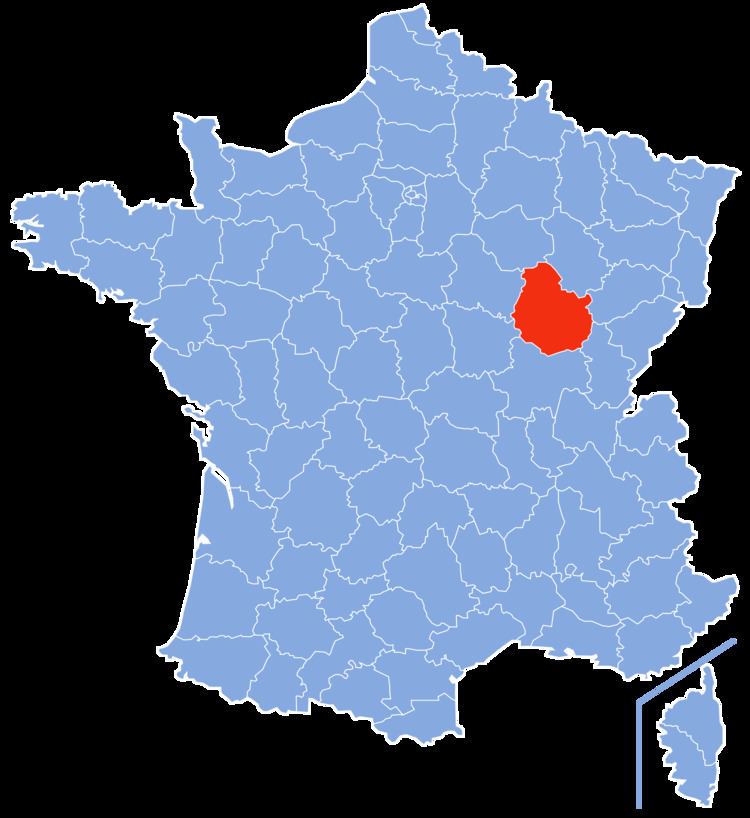Country France Highest elevation 723 m (2,372 ft) Area 8,763 km² | Subprefectures BeauneMontbard Time zone CET (UTC+1) Population 529,761 (2013) | |
 | ||
Region Bourgogne-Franche-Comté Demonym(s) côte-d'oriens, costaloriens Points of interest Hospices of Beaune, Abbey of Fontenay, Musée des Beaux‑Arts de Dijon, Jardin botanique de l'Arqu, Dijon Cathedral Colleges and Universities University of Burgundy, ESC Dijon Bourgogne, École nationale supérieur, ESIREM | ||
Côte-d'Or ([kot dɔːʁ]; literally, "golden slope") is a department in the eastern part of France.
Contents
Map of C%C3%B4te-d'Or, France
History
Côte-d'Or is one of the original 83 departments created during the French Revolution on 4 March 1790. It was formed from part of the former province of Burgundy.
Geography
The department is part of the current region of Bourgogne-Franche-Comté. It is surrounded by the departments of Yonne, Nièvre, Saône-et-Loire, Jura, Aube, and Haute-Marne.
A chain of hills called the Plateau de Langres runs from north-east to south-west through the department to the north of Dijon and continues south-westwards as the Côte d'Or escarpment, which takes its name from that of the department. It is the south-east facing slope of this escarpment which is the site of the celebrated Burgundy vineyards. To the west of the Plateau de Langres, towards Champagne, lies the densely wooded district of Châtillonais. To the south-east of the plateau and escarpment, the department lies in the broad, flat-bottomed valley of the middle course of the Saône.
Rivers include:
Climate
The climate of the department is temperate, with abundant rain on the west side of the central range.
Politics
The President of the General Council is François Sauvadet of the New Centre.
Economy
This is a premier wine-growing region of France. It produces what are arguably the world's finest, and definitely most expensive Pinot noir and Chardonnay wines from some of the most rigorously and painstakingly (thanks to the region's many monasteries) classified vineyards in the world. Wine from the Côte-d'Or was a favorite of the emperor Charlemagne. Other crops include cereal grains and potatoes. Sheep and cattle are also raised in the department. The region is famous for its Dijon mustard.
There are coal mines and heavy industry, including steel, machinery, and earthenware. The industries most developed in Côte-d'Or are
The big works are generally in the conurbation of Dijon although biggest (CEA Valduc) is at Salives in the Plateau de Langres. There is also the SEB metal works at Selongey below the plateau on the margin of the Saône plain and the Valourec metalworking group at Montbard in the west of the department on the River Brenne near its confluence with the Armançon. The Pharmaceutical industry has shown the greatest growth in recent years. However, since the Dijon employment statistics zone includes the urban and administrative centre of the Burgundy region, the service sector is proportionately bigger there in relation to the industrial, than in the other three zones of Côte-d'Or.
Demographics
The inhabitants of the department are called Costaloriens.
Tourism
Some of the major tourist attractions are the Gothic abbey church of Saint-Seine-l'Abbaye and the Romanesque abbey church at Saulieu, as well the Château de Bussy Rabutin at Bussy-le-Grand. The Abbey of Cîteaux, headquarters of the Cistercian Order, lies to the east of Nuits-Saint-Georges in the south of the department.
